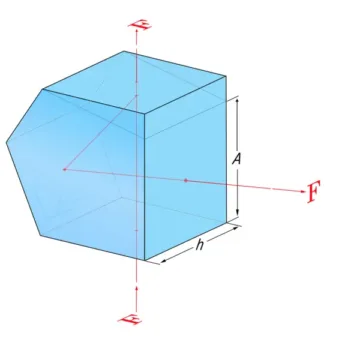-
Beamsplitter Penta Prism is produced by bringing together a precision Penta Prism and a wedge prism and adding an appropriate interference coating to one of the typically reflective surfaces. Since minor motions of a Penta Prism do not influence the true right angle at which light rays are reflected, the difference between the light rays transmitted and reflected is highly controllable
-
Brewster Windows are windows that are meant to be used at Brewster's angle (usually uncoated). This is the angle at which only incident p-polarized light has 0% transmission loss. Instead of exterior mirrors, a Brewster window is an uncoated substrate positioned at Brewster's angle within a laser. This substrate works as a polarizer, allowing p-polarized light to enter and exit the window without reflection losses while reflecting s-polarized light. Features
- Perfect for Laser Cavities.
- A substrate with UV Fused Silica.
- Without Reflection Losses, P-Polarized Light is Transmitted.
-
Calcium Fluoride (CaF2) Windows have a high damage threshold and low absorption and are transparent from 180 nm to 8µm. It is a great choice for FTIR analysis, excimer laser systems, spectroscopic windows, and thermal imaging systems. Features:
- <1 arc-minute parallelism
- Ideally suited for excimer laser applications.
- Transparent in UV, visible, and infrared light.
- A low absorption rate and a high damage threshold
- In comparison to other IR materials, it has a low chromatic aberration.
-
Dove prisms are reflective prisms that are used to invert images. A truncated right-angle prism is used to build dove prisms. Roof prisms are commonly used in optical equipment like digital optoelectric products, imaging equipment, fingerprint systems, medical devices, precise digital control machinery and other optical fields, common science educational equipment, optical communication, etc.
-
A Penta Prism is a five-sided reflective prism used to scatter a light beam by 90 °. The beam reflects twice inside the prism, allowing an image to be transmitted through a right angle without inverting it (i.e., without altering the handiness of the image) as an ordinary right-angle prism would. For optimum performance in the ultraviolet (UV), visible, or infrared (IR) spectrums, z-optics provides a selection of Penta Prisms. In addition, we provide half Penta prism. Without flipping or reversing the image, it is used to shift the line of sight by 45°. It is frequently used in telescopes and also has uses in geodesy, microscope tubes, projection and image systems, and Penta prism, half-Penta prism, and precision prism are all products that we manufacture in China. Please get in touch with us directly for pricing information or details on prisms that might work for your application.
-
The Rhomboid Prism is a parallelogram with uneven length neighbouring sides and non-right angled angles. Rhomboid prisms are frequently used to dispense a laser beam while maintaining its direction. Rhomboid prisms will shift the optical axis in imaging applications without inverting the picture. They have high tolerance angles, which ensure that the output beam is parallel to the input beam within 30 arcseconds. Features - 1. Lateral Beam Displacement. 2. Parallel Input and Output Beams to 30 Arcseconds. 3. Repositions the optical axis without inverting the image. 4. Exceptionally well-suited for severe displacement applications.
-
A roof prism is a transparent optical marvel that comprises a segment where two faces meet at an angle of 90°, resembling the roof of a house and inspiring the name of this exceptional feature. This unique design allows the reflection of the two 90° faces to return an image that is laterally flipped around the axis where the faces meet, ensuring top-notch image inversion and precise orientation adjustments.
-
-
Zinc Sulphide (ZnS) windows have a high transmission range of 8-14 microns in the infrared (IR). It offers a wide transmission range for visible and mid-wave or long-wave infrared sensors, making it the ideal material for thermal imaging. Features
- Zinc Sulfide Substrate Multispectral Grade
- Low Absorption and Scatter from 0.4 to 12m
- Available uncoated or with an 8 to 12μm Broadband AR Coated Option











